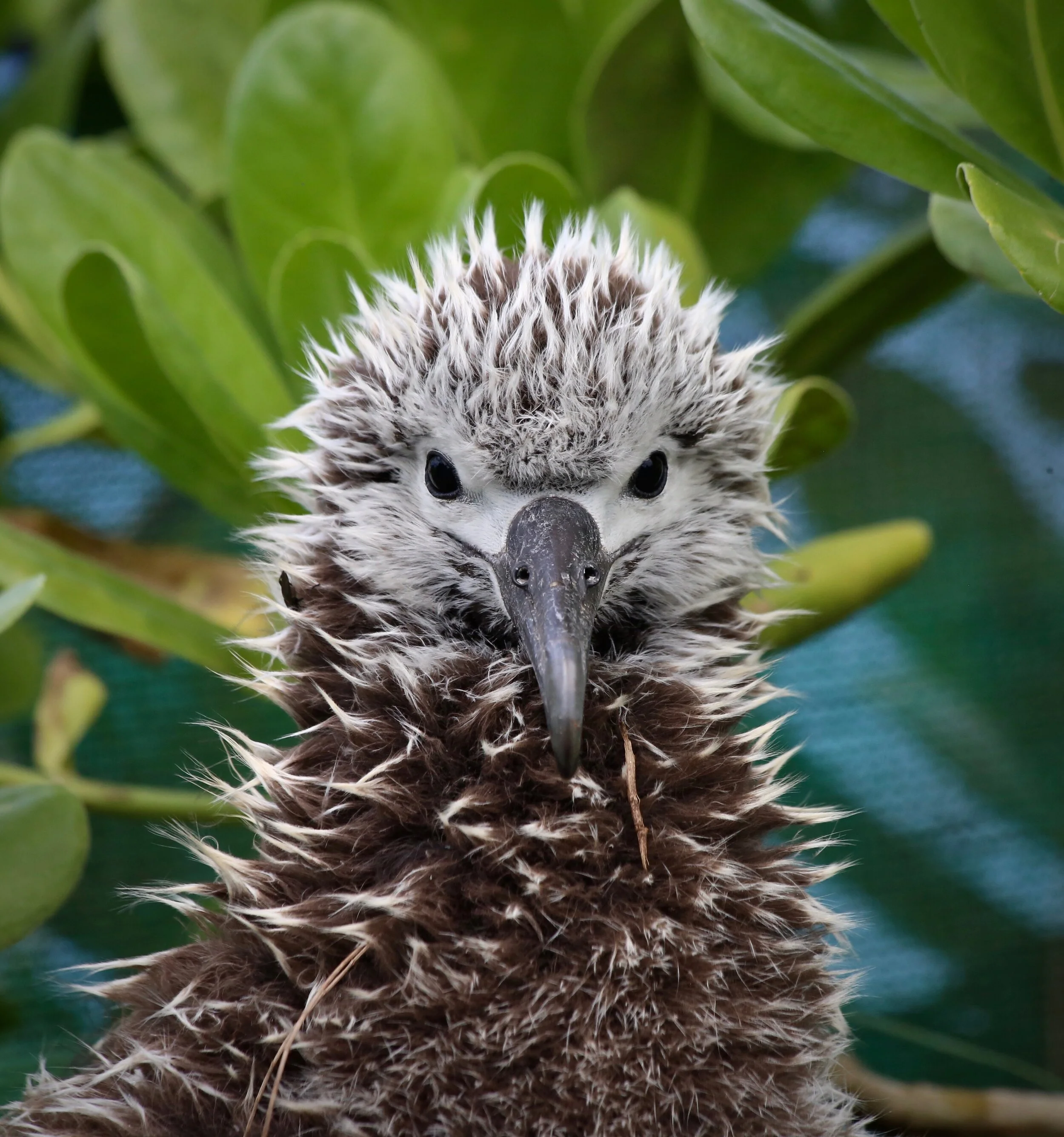"Birds of Kīlauea Point": New Book Coming Soon
By Hob Osterlund, Safina Center Fellow
In the Hawaiian Islands, our feathered friends are unlike anywhere else in the world: not only are they beautiful birds, they are riddles and myths and mysteries.
Mōlī (Laysan albatross) in flight near Kīlauea Point National Wildlife Refuge. Photo: Hob Osterlund
Mōlī (Laysan Albatross) moo like cows, whinny like horses and live longer than any other wild bird. Soaring ‘Iwa (Great Frigatebirds) summon ancient memories of feathered dinosaurs. Koaʻe ʻUla (Red-tailed tropicbirds) fly backward circles, trailing their feathers like airplane banners advertising their splendor. ʻĀ (Red-footed Boobies), despite their clownish monikers, sport daggers on their faces. After dark, Aʻo (Newell’s shearwaters) bray overhead as if donkeys could really fly.
Aʻo (Newellʻs shearwater) chick ready to fledge. Photo: Hob Osterlund
In the wetlands, Aeʻo (Hawaiian stilts) strut tall on their English names. Nēnē (Hawaiian geese) graze calmly among us, as if they hadn’t just moments ago teetered on the edge of extinction’s calamitous cliff. Koloa Maoli (Hawaiian ducks) are seeing-eye ducks for blind human warriors. ʻAlae ʻUla (Hawaiian Gallinules) fetch fire from the gods and burn their foreheads on the way. ʻAlae Keʻo Keʻo (Hawaiian Coots) get religion and run on water, aided by the weirdest reptilian toes you ever saw.
Nēnē (Hawaiian goose) pair. Photo: Hob Osterlund
In the forests, I’iwi beaks are commas in a run-on sentence we pray never ends. On the shores and grasslands, Kōlea (Pacific Golden Plovers) dress up in handsome tuxedos to prepare for their sprint to the Arctic. In among the flowers, Hawaiʻi hummingbirds are really moths.
At Kīlauea Point National Wildlife Refuge (KPNWR,) seabirds dominate the landscape. Their nesting grounds are there. They reunite with their long-term mates there. They lay their eggs and raise their babies there. Their chicks fledge from there.
Mōlī (Laysan albatross) chick, two months old. Photo: Hob Osterlund
Some species reside on the refuge year-round; some forage over the vast North Pacific for several months, then return for nesting season.
All seabird pairs at KPNWR raise only one babe a year, max. Finding food is hard work, and one offspring is all they can afford. If that chick fails, the breeding season is over until next year.
Why would a chick fail? The oceans are changing. As they get warmer and more acidic, the food web weakens. Plastics are too often mistaken for food or accidentally ingested. When parents cannot find enough nutrition, they and their little ones pay a big price.
On the ground there are predators. Cats, dogs and pigs are all non-native on Kauaʻi. Since humans brought them, it’s humans who are responsible for the birds’ protection—and providing the safest possible home for native birds is the very reason KPNWR exists.
The refuge also hosts an assortment of non-native birds. At least one species arrived on Polynesian voyaging canoes. Some came by accident, off course from their typical migration. Several were introduced on purpose. Some are invasive and destructive; some are harmless and charming.
Rooster (Moa junglefowl). Photo: Hob Osterlund
They all add up to a total bird population unlike anywhere else in the world.
When the time is right, come visit. Don’t hurry off; stay awhile. Tell us what you see. Ask questions. Learn how you can help. Most of all allow the magnificence of Kīlauea Point National Wildlife Refuge into your hearts; then be sure to take it home with you.
Kīlauea Point National Wildlife Refuge from Nīhoku overlook. Photo: Hob Osterlund
Hob Osterlund is the author of Holy Mōlī: Albatross and Other Ancestors (Oregon State University Press, 2016.) Her book Birds of Kīlauea Point will be published this year in partnership with Friends of Kauaʻi Wildlife Refuges.






